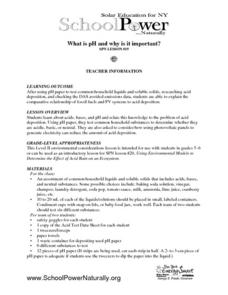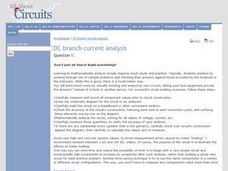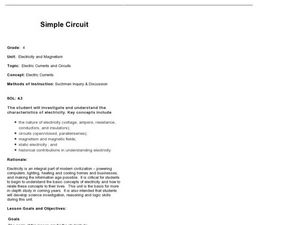Curated OER
Fourth Grade Science
In this science activity, 4th graders complete multiple choice questions about electricity, the sun, sound, and more. Students complete 25 questions.
Curated OER
What is pH and Why is It Important?
Students investigate about acids, bases, and pH and relate this information to the problem of acid deposition. They use pH paper, students test common household substances to determine whether they are acidic, basic, or neutral. Pupils...
Curated OER
Get Charged!
Students explore the concept of electricity in this activity based unit. In this physical science lesson, students focus on electricity and electrical engineering. The teaching unit includes 5 activities to develop students...
Curated OER
Lesson Plan: ABC's of Electricity
Students are able to identifty items that use electricity. They identify 10 household items that run on electricity. Students understand and articulate that electricity is to be respected. Electricity is helpful, but it also can cause...
Curated OER
DC Branch Current Analysis
Engage your class in physics with this series of questions. The first question is the most hands-on and asks learners to build their own circuit. The rest of the questions are related to current analysis. Class members solve 7 problems...
Curated OER
Green Team
Student explore the relationship of static electricity to current electricity, circuits, electromagnets, electro generators, and public electric utilities. In this Green Team lesson plan, 4th graders participate in hands-on science...
Curated OER
Summer Bridge Activities 4-5
In this cross-curricular worksheet, students complete various activities. They complete a crossword puzzle dealing with electricity, change mixed numbers into decimals, subtract fractions, identify adjectives in sentences, solve money...
Curated OER
Electricity
Students explore where electricity comes from and how it is used in their everyday lives. Through discussion and hands-on activities, they define electricity and explain how it travels to our homes. Students make informed choices based...
Curated OER
Nineteenth Century Progress
Highlight some of the major players and progressive inventions that shaped the latter half of the 19th century. From Thomas Edison to Vaudeville, this outline of pop and tech culture provides an American cultural context. Note: Use this...
Curated OER
The Incorporation of America
The incorporation and industrialization of America is covered in this image-rich slide show. While text is limited, there is no shortage of great images showing the progression and causes of American Industrialization. Perfect...
Curated OER
Simple Circuit: Electric Currents and Circuits
Through inquiry and exploration, 4th graders will learn and understand the functions of open and closed circuits. They will break into 2 groups, define vocabulary, hypothesize how to light a bulb, then test their hypothesis 4 different...
Curated OER
Electrical Circuits
By following this PowerPoint, your class will gain many of the details needed to build correct and safe circuits. The details in this clear set of slides are concise and are given in a logical sequence. The many examples will...
Mr. E. Science
Electricity and Magnetism at Work
I don't get electricity jokes, watts so funny about them? The 13th in a series of presentations covers energy, motors, currents, generating electricity, calculating electrical energy cost, transformers, and batteries.
Wind Wise Education
Understanding Electric Power Generation
You mean the electricity does not come from the switch? As a class and in small groups, learners explore the sources of energy used to generate electric power. Worksheets guide groups into choosing a future electricity generating...
Scholastic
On or Off?
How does electricity work? Put an electric circuit into your own hands with a short experiment that makes a switch out of a battery, light bulb, and thumb tacks. Young scientists then respond to short answers about why the circuit...
Exploratorium
Short Circuit
Though not commonly searched for, this is a vivid demonstration of how a fuse can be blown, or rather, how resistance works in an electric circuit. You will basically set up a circuit with no lights or bells or motors, allowing the wire...
Carnegie Mellon University
Battery Workshop
Introduce your class to the workings and parts of a battery-operated circuit. Pairs of pupils use lemons to make batteries and measure voltage and current with a multimeter. An accompanying worksheet is used for recording values and...
Curated OER
The Impact
Students study different inventors and inventions. In this invention introduction lesson plan students pretend that they are an inventor and come up with their own invention.
Curated OER
Battery fun
Conduct an experiment with batteries to make a simple circuit. Fifth graders read the provided information, consider the two circuits, and determine which one is complete. An electrically charged experiment suggestion is included. Tip:...
Curated OER
Wire Maze
Middle school electrical engineers design a maze out of wire and connect it in a circuit to a noise-making or lighting device. The idea is to string a paperclip along the wire without touching it along the way. The noise-maker or light...
Curated OER
Series and Parallel Circuits
Electricians draw four different circuits and answer questions about the resistance, voltage drop, and current at different points in each. Completing this worksheet will help make sure that your class is understanding what is happening...
Curated OER
Power Problem
Students complete an electricity activity to learn about power outages, insurance, and weather preparation. Students use the worksheet 'Power Problem Work Sheet' and use the 'Global Grocery List Project price list for the U.S.' to...
Curated OER
Simple Atomic Structure
Atomic structure is reviewed with connection to the gain or loss of electrons. The movement of electrons and the resulting behavior is summarized. Practical uses of static electricity is explained, with diagrams of the most common...
Curated OER
Simplicity of Electricity
Students examine how to make an electrical circuit. They listen to a teacher led discussion, design a switch to control a circuit, and construct a signaling device.

























